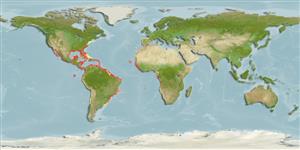Occurs on continental and insular shelves, frequenting mangrove fringes, coral keys, docks, sand or coral mud bottoms, saline creeks, enclosed bays or sounds, and river mouths. May enter fresh water. Occasionally moves into the open ocean, near or at the surface, apparently for purposes of migration. May rest motionless on the bottom (Ref. 9710). May occur singly or in small groups. Feeds mainly on fish but also takes crustaceans and mollusks. Viviparous, with 4 to 17 young in a litter. Size at birth 60 to 65 cm. Has been involved in several attacks on people. Meat is utilized for human consumption, hides for leather, fins for shark-fin soup base, liver oil for vitamins, and carcasses for fish meal. Marketed fresh, dried-salted and frozen (Ref. 9987).
生活于被常常聚集于红树林穗缘,珊瑚钥匙,船坞,沙子或珊瑚泥底,咸度小溪,封闭的海湾或声音 , 与河口的大陆架与岛屿棚。 可能进入淡水。 偶然地移入开放性海域, 接近或在水表面, 显然地对于迁移的目的。 五月在底部上让不动的休息。 (参考文献 9710) 可能单独出现或形成小群鱼群。 主要吃鱼也捕食甲壳动物与软件动物。 胎生的, 有四个到 17 幼鱼在一胎。 出生时的大小 60 到 65 公分。 曾经关系到一些对人的攻击。 肉被供人类消费使用, 皮用做皮革,鳍用于鱼翅汤底,肝油用于维他命与残骸用于鱼粉。 在市场上销售生鲜地了, 乾燥盐腌与冷冻.(参考文献 9987)
Preferred temperature (Ref.
115969): 21.9 - 28, mean 25.6 (based on 714 cells).
Phylogenetic diversity index (Ref.
82804): PD
50 = 0.7500 [Uniqueness, from 0.5 = low to 2.0 = high].
Bayesian length-weight: a=0.00490 (0.00257 - 0.00934), b=3.11 (2.95 - 3.27), in cm Total Length, based on LWR estimates for this species & (Sub)family-body (Ref.
93245).
营养阶层 (Ref.
69278): 4.3 ±0.5 se; based on diet studies.
回复力 (Ref.
120179): 非常低的, 最小族群倍增时间超过14 年 (K=0.54(?); tm=12.7; tmax=25; Fec = 4-17; rmax = 0.012).
Fishing Vulnerability (Ref.
59153): High to very high vulnerability (73 of 100).
Climate Vulnerability (Ref.
125649): Very high vulnerability (76 of 100).
